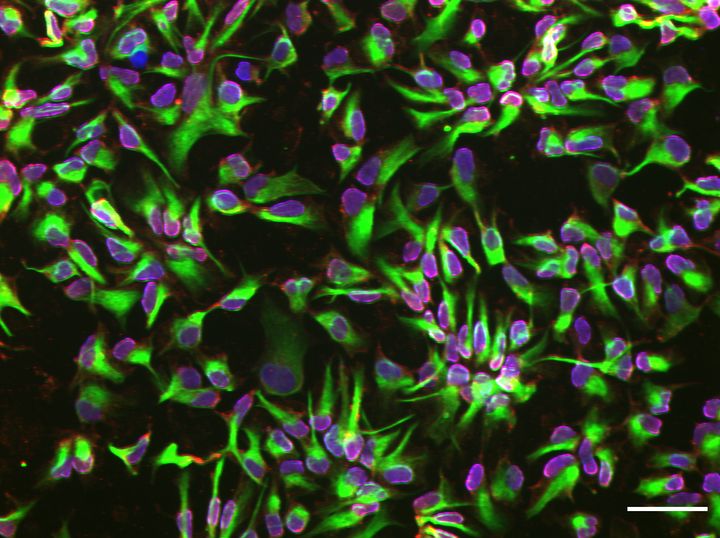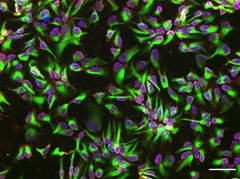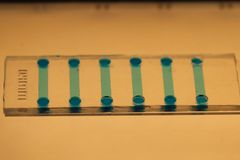Device improves stem cell generation and chance for accessible Alzheimer’s cell therapy
Researchers in Sweden say they have improved on a technique for converting regular skin cells into neural stem cells—an advance which they say helps close the gap for accessible personalized cell-based therapies for Alzheimer's and Parkinson's.

Using a specially-designed microfluidic device, the research team have developed an unprecedented and speedier approach to reprogramming human skin cells into induced pluripotent stem cells (iPSCs), and further transforming them into neural stem cells.
The study’s first author, Saumey Jain, says the platform could improve and lower the cost of cell therapy, making cells easier to match and be accepted by a patient’s body. The research was reported in Advanced Science by researchers from KTH Royal Institute of Technology.
Anna Herland, the senior author of the study, says the study demonstrated the first-ever case of microfluidics being used to redirect iPSCs toward becoming neural stem cells.
Engineering the transformation from regular cells into neural stem cells is in effect a two-stage process. Using a process that involves exposing cells to biochemical cues, the cells are induced into pluripotent stem cells (iPSCs), which have the power to generate different cell types.
Then they are transferred to a culture medium that mimics the signaling cues and developmental processes involved in formation of the nervous system. This stage, called neural differentiation, redirects cells to commit to being neural stem cells.
The medium for this kind of lab work has been shifting from well plates to microfluidic devices for nearly a decade. Herland says the new platform represents an improvement of microfluidics for both stages, iPSC generation and neural stem cell differentiation.
Using cells from a human skin biopsy, they found that the microfluidic platform enabled a boosted commitment to their neural fate at an earlier point than those differentiated in a conventional well plate format.
“We documented that the confined environment of a microfluidic platform boosts neural stem cell generation commitment,” Herland says.
Jain says the microfluidic chip is easy to fabricate using polydimethylsiloxane (PDMS), and its microscale size offers substantial cost savings in terms of reagents and cellular input.
The platform can be easily modified to enable adaptability for differentiation into other cell types, he says. It can be automated, providing a closed system that ensures consistency and reliability in producing highly homogenous cell populations.
“This marks a step towards making personalized cell-based therapies for Alzheimer's and Parkinson's accessible.”
Contributing to the study were researchers from Karolinska Institutet and Lund University collaborating in the VINNOVA-funded consortium IndiCell.
Contacts
David CallahanInternational Public Information OfficerKTH Royal Institute of Technology
press@kth.seImages
Subscribe to releases from KTH Royal Institute of Technology
Subscribe to all the latest releases from KTH Royal Institute of Technology by registering your e-mail address below. You can unsubscribe at any time.
Latest releases from KTH Royal Institute of Technology
Leading academics call for extending, reframing Sustainable Development Goals17.6.2024 10:46:06 CEST | Press release
A group of leading academics are calling for the UN Sustainable Development Goals to be extended past their 2030 target date and updated with consideration for the impact of artificial intelligence (AI), and with more input from communities affected by the goals, among other recommendations.
1,000 times smaller than a grain of sand—glass sensors 3D-printed on optical fiber15.5.2024 15:06:46 CEST | Press release
In a first for communications, researchers in Sweden 3D printed silica glass micro-optics on the tips of optic fibers—surfaces as small as the cross section of a human hair. The advance could enable faster internet and improved connectivity, as well as innovations like smaller sensors and imaging systems.
Climate is one culprit in spread and growth of Middle East dust levels30.4.2024 08:49:52 CEST | Press release
Climate change is transforming dust storms—a natural phenomenon in the Middle East—into a more frequent and widespread threat to health and economies throughout the region, a new study shows.
Global warming and plastic pollution entwined in vicious circle, report says19.3.2024 10:56:01 CET | Pressmeddelande
Typically viewed as unrelated problems, global warming and plastic pollution are instead inextricably trapped in a “vicious circle” where one feeds the other, researchers in Sweden report in Nature Communications. The mutually-reinforcing relationship escalates global warming, the degradation of materials, plastic waste and the leaching of toxic chemicals into the biosphere.
New hydrogen producing method is simpler and safer7.3.2024 13:57:26 CET | Press release
Researchers in Sweden unveiled a new concept for producing hydrogen energy more efficiently, splitting water into oxygen and hydrogen without the dangerous risk of mixing the two gases.
In our pressroom you can read all our latest releases, find our press contacts, images, documents and other relevant information about us.
Visit our pressroom

